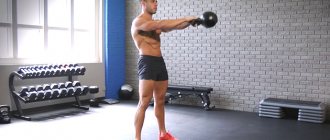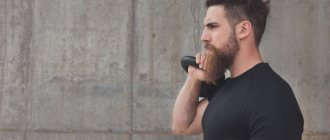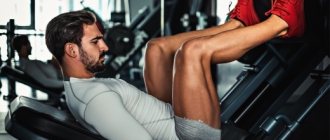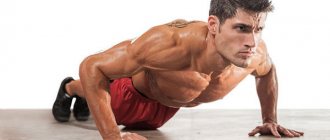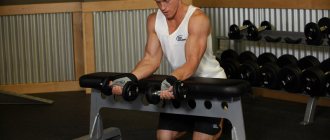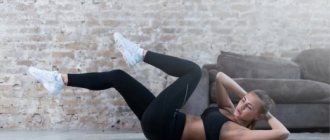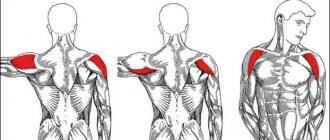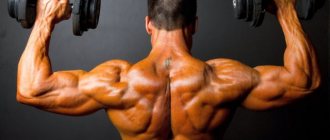Causes and consequences of slouched shoulders
The human spine has slight natural curves that are necessary for shock absorption and maintaining a center of gravity. But when these curves exceed the norm, it affects posture and overall health. For example, an excessively arched thoracic spine manifests itself in the form of hunched shoulders. This deviation is called kyphosis, and occurs in 10% of the world population.
Kyphosis can manifest itself at any age, but teenagers and old people are most susceptible to it. The causes of the disease include:
- Passive lifestyle. For this reason, stooping develops in office workers, schoolchildren and students.
- Weakening of the back muscles, caused by the lack of sports and manual labor in life.
- Too tall. The problem may arise due to constraint or physical inconvenience due to low doorways and ceilings.
- Poorly structured training. For example, a person actively pumps the pectoral muscles, but does not pay any attention to the back muscles, as a result of which the shoulders are pulled forward.
- Congenital weakness of connective tissues. Children with this problem can develop kyphosis even from wearing too heavy winter clothing.
- Congenital vertebral deformity (Scheuermann-Mau disease).
- Paralysis of the spinal muscles caused by cerebral palsy, polio and other diseases.
- Rickets.
- Spinal injuries.
- Osteochondrosis. The disease leads to gradual subsidence of the intervertebral discs and curvature of the spinal column. This is the main reason for stooping in old age.
- Psychological reasons. Kyphosis most often occurs in people who lack self-confidence, as well as in children experiencing increased pressure from their parents.
The causes of stooping are quite varied, and not all of them can cause you to try to straighten your shoulders with exercises on your own. If the curvature is a consequence of injury or a serious illness, the spine can be restored only under the supervision of a doctor. If this is a consequence of sitting at the computer for many hours, then you need to accustom yourself to sit with a straight back, and at the same time, with the help of sports, begin to correct the problem.
People who did not take care of correcting their posture in their youth face severe back pain by the age of 40-50. Displacement of internal organs and problems with the limbs, which are deprived of normal blood supply due to a crooked spine, are also likely.
The mechanism of occurrence of pathology
When one shoulder is lower and the other is higher, this is always associated with curvature of the spine.
This pathology in medicine is called “scoliosis”. According to statistics, it occurs most often in children from 7 to 15 years old. After all, it is at this time that a huge load is placed on the not yet formed spine. The child is forced to sit at the table for a long time. His muscles cannot support the spine and become tired. Because of this, the child involuntarily bends his back, lowering 1 shoulder. Flexibility of the bones and laxity of the ligaments maintain the curvature, so it remains even when moving. This pathology rarely occurs in adults, and even less often they go to the clinic with it. After all, it is difficult to independently control the symmetry of the shoulder girdle, and this condition usually does not cause discomfort. The deformity is detected in an adult with back pain, numbness in the legs or arms, lameness, dizziness and other consequences. In this case, it is almost impossible to correct the situation; you can only stop the progression of the deformity.
Is it possible to straighten your shoulders with exercises?
You can straighten your shoulders with exercises aimed at strengthening your back muscles. First of all, these are the muscles located between the shoulder blades:
- diamond-shaped;
- trapezoidal;
- paraspinal;
- infraspinatus.
If you purposefully pump these muscles, the shoulder joint gradually straightens, and the stoop goes away. Attention should also be paid to other muscles that support posture - deltoid, gluteal and neck muscles.
Stretching exercises will also be useful, since not only weakened, but also overly tense muscles can lead to curvature. This problem often affects people who work out intensively in the gym. To eliminate and prevent kyphosis, regular stretching of the muscles of the neck and chest is especially important. In addition to exercise, relaxation can be achieved through massage.
How to fix one shoulder higher than the other
In this episode of the TV show “Live Healthy!” with Elena Malysheva you will learn about the treatment of childhood scoliosis. What useful devices are there for nursing mothers? What are the benefits of blueberries? What problems are women embarrassed to talk about?
Subscribe to the official channel “Live Healthy!” — https://www.youtube.com/channel/UCDFu23EzyZMVGvify__5ndw?sub_confirmation=1
Childhood scoliosis does not cause pain in the child, but after a few years it can lead to deformation and displacement of internal organs
Signs of spinal curvature:
- one shoulder girdle is higher than the other;
- the lumbar triangle is absent on one side;
- the angle of one shoulder blade is closer to the spine than the angle of the other;
- when bending forward, one side of the ribs is slightly higher than the other.
What's happening
Scoliosis is dangerous because it does not cause pain. However, after a few years, scoliosis can lead to confusion of internal organs, a change in the curvature of the aortic arch, and this is a prerequisite for hypertension. Also, scoliosis often causes prolapse of the kidney, the ureter becomes tortuous, which threatens urolithiasis. Thus, all the conditions arise for the deformation of internal organs.
How to treat
For timely and correct treatment, at the slightest suspicion of a change in posture, consult a doctor. In the first stages, scoliosis can be corrected with regular exercise and massage procedures.
If scoliosis becomes malignant, progresses, and the angle of curvature becomes more than 30 degrees, the patient is indicated for surgical treatment. With the help of rod or plate structures, the spine straightens and begins to grow correctly.
Prevention
- Take the child to an orthopedic doctor once a year: even if the child does not have symptoms of scoliosis, once a year, starting from the age of 7, you should take the child for examination to an orthopedic traumatologist or a neurologist.
— properly arrange the child’s workplace, for example, use a transforming table. Children grow quickly, so the height of the table must be adjustable. The chair should be curved forward to support the lumbar spine;
— it’s also good to use a transforming chair: its back should move back and forth and up and down, the legs should be bent at a right angle, and the back should fit snugly against the back of the chair.
Orthopedic doctor Alexander Laka takes part in the program
How to turn your shoulders back with exercise therapy?
Physical therapy not only strengthens the back muscles, but also instills the habit of maintaining correct posture. The process is long, the first results can be seen no earlier than 3 months of training, and full recovery will take about six months. Moreover, success is possible only with a systematic approach. Shoulder straightening exercises should be done at least 3 times a week, but it is better to pay attention to them daily.
Let's look at a few exercises that help form the habit of keeping your back straight:
Exercise No. 1 . We stand against a flat wall, pressing our whole body closely against it. If the stoop is still weakly expressed, or gymnastics is performed for prevention, the body will have 5 points of contact with the wall - the heels, the calf and gluteal muscles, the shoulder blades and the cervical spine. Staying in this position for 10-15 minutes a day will help the body remember correct posture.
Exercise No. 2 . Forms the habit of keeping your back straight when walking. To perform it you will need a gymnastic stick. We place it parallel to the floor behind the back at lumbar level. Holding the stick with your elbows, we walk with it for 15-20 minutes a day. Additionally, you can bend towards the floor.
Exercise No. 3 . We stand facing the wall, take a step back and rest our palms on it. Without moving your legs or bending your straightened arms, we begin to slowly lean towards the wall. In this exercise, you should only move your shoulders, which need to be turned back as much as possible. The forward movement is performed while inhaling, backward while exhaling. We do 6 such tilts in total.
Exercise No. 4 . For this you will again need a stick, which can also be replaced with a belt or a long towel. Taking the stick from both sides at a distance slightly wider than the shoulders, we begin to slowly raise our arms in front of us, trying to move them behind our heads. We make sure that the shoulders do not rise along with the arms. We repeat the movement 5-7 times.
Exercise No. 5 . We spread our arms to the sides, then begin to slowly move them behind our backs. Then we lower it down and repeat the movement 5 more times.
Such exercises are good for preventive purposes, as well as for slight stooping caused by a sedentary lifestyle. If you have muscle atrophy, you will need more intense exercises to strengthen your back muscles.
How to quickly get rid of slouch at home
At the end of the complex, it is recommended to perform several lower yoga asanas.
Due to sedentary work, the mobility of the shoulder girdle is often impaired, tension and pain occur. A complex for increasing shoulder mobility will help to cope with the problem. The exercises are simple and can be done safely at home on your own.
Set of exercises:
- Standing in front of a mirror, pull your shoulders back, bringing your shoulder blades together as much as possible. Fix the position on the count of 5, relax.
- Raise and lower your shoulders alternately and together, try to keep your shoulder blades brought together.
- Perform rotational movements with your shoulders forward and backward.
- Stretch your arms to the sides, raise them to shoulder level, and place your palms down. Make rotational movements forward and backward.
- In a sitting position, place your right hand on your chest, clasp it with your left hand, and gently stretch the shoulder muscles. Hold the position for 1 minute.
- Clasp your hands behind your back. In this position, try to raise your arms up.
Repeat each exercise 10-15 times.
At the end of the workout, you can perform several lower yoga asanas - downward-facing dog, child's pose.
Sets of exercises for straightening shoulders
The following exercises will help strengthen your back and relieve muscle spasms at the same time:
Exercise No. 1 . We lie down on our stomachs. We place our hands along the body, palms down. Legs are relaxed. Without leaning on your arms and without lifting your palms from the floor, slowly lift your body up as you inhale. Hold for a couple of seconds, and as you exhale, lower back down. The movement should be accomplished through the efforts of the back muscles. We do 8-12 repetitions in total.
Exercise No. 2 . Similar to the previous one, only we bend our arms at the elbows and turn them to the sides. We press our fingers into our temples.
Exercise No. 3 . We lie on our backs, arms along the body. We bend one leg at an angle of 90 degrees and slowly raise it above the floor by 20-30 cm. We hold it at the top for a couple of seconds and return it back. We do 6 repetitions with each leg.
Exercise No. 4 . We lie on our stomach, stretch our arms straight forward. As you inhale, slowly raise your right arm and left leg at the same time, and then your left arm and right leg. We do these alternating movements 6 times on each arm and leg.
Exercise No. 5 . We lie down on our stomachs. We bend the right leg at the knee and use our hands to pull it towards the buttocks. At the same time, the shoulders turn back. We hold for 30 seconds. Repeat with the left leg.
Exercise No. 6 . It is performed similarly to the first, only we raise our arms up together with the body, while turning our shoulders back and bringing our shoulder blades together.
Exercise No. 7 “Cat” . We get down on all fours. Slowly arch your back upward, lowering your head down. Then we bend our back down, shoulder blades together, face looking up. Repeat 6 times.
Exercise No. 8 . We sit on the floor, legs extended forward. Tilt your body and try to reach your toes. We do not bend our back and legs. Maintain the position for 30 seconds. If you can’t reach your feet, you can put a belt over them.
This complex will be useful not only for kyphosis, but also for scoliosis of 1 and 2 degrees. It will also help alleviate the condition of osteochondrosis.
We recommend: a trusted sports nutrition store with working supplements and competent consultants!
A set of exercises on a fitball
Using a fitball allows you to more effectively strengthen your back muscles and increase the flexibility of your spine. The following exercises will be useful for stooping:
Exercise No. 1 . We lie with our stomach and thighs on the ball, positioning it so that our feet can rest against the wall. We place our hands behind our heads in a lock. As you exhale, we raise the straight body, and as we inhale, we lower ourselves back. The exercise simulates hyperextension raises. We perform 15-20 repetitions in total.
Exercise No. 2 . We place the fitball under the lower back, with the arms and legs resting on the floor. Using the movement of the legs, we roll the ball along the back and hips. We perform the exercise for a minute.
Exercise No. 3 . Standing in front of the fitball, we tilt our straight body forward. Arms are straightened, palms are located in the middle of the ball. Gradually we begin to roll the ball away from ourselves, thereby bending the upper body down even more. Do not lift your heels off the floor.
The fitball can be used not only to strengthen the back, but also to train the deltoids, which is also very useful for stooping. To do this, you need to perform push-ups from the floor with your feet raised on the ball. At the same time, place your hands slightly wider than your shoulders, and the whole body should stretch out in a straight line. As you inhale, slowly bend your elbows, bringing your chest as close to the floor as possible. As you exhale, we rise back up.
It is not recommended to perform classic push-ups while slouching, as they strengthen the chest muscles, thereby pulling the shoulders forward even more. But using an elevation for the legs allows you to transfer the load from the chest to the deltoids and arm muscles, therefore it has a positive effect on posture.
This video will be useful for those who want to correct their posture and straighten their shoulders:
Description of the pathology
Scoliosis (specialists also often use the term “scoliotic disease”, which refers to severe congenital deformities of the spine with a progressive course) is a vertebral pathology, a lateral or frontal curvature of the spine relative to the midline (central axis). In almost 60% of cases, scoliosis is considered idiopathic, then Yes, it is not possible to find the root cause of its development, although generally accepted risk factors for this pathology are known. Unlike sagittal curvature, which is formed in the corresponding plane (back and forth), with scoliotic deformation, certain segments of the spinal tube deviate away from its central part. The main symptom of scoliosis is the asymmetry of the shoulder girdle: one shoulder is noticeably higher than the other, while the difference between the height of the shoulders in severe forms of scoliotic disease can reach 25-30 cm.
Main signs of scoliosis
Training in the gym - will exercises help straighten your shoulders?
The gym will help strengthen your back muscles much faster than working out with free weights. The most effective exercises to correct slouching are:
Pulldown of the upper block to the chest . The exercise uses all the muscles of the upper back and the front deltoids. Sit in the pulley machine with the handle directly above your head. Arch your lower back, leaning back slightly. Take the handle with a straight, wide grip and, as you exhale, lower it until it touches your upper chest. As you inhale, return the handle back, but not until your arms are fully straightened, so that the load does not leave the back muscles. Select the weight so that you can do 10-12 repetitions in 3 sets.
Pull the lower block to the stomach . This exercise works the back muscles and rear deltoids. The machine must be equipped with a horizontal block with a V-shaped handle. Sit on a bench, straighten your shoulders, place your feet on the platform in front of you. Hold the handle with your palms facing each other and, keeping your body still, pull it toward your lower abdomen as you exhale. Make the effort with your back, not with your hands, while trying to bring your shoulder blades together as much as possible. The number of repetitions is the same as in the previous exercise.
Pull-ups in anti-graviton . Grasp the horizontal bar with a wide grip, place your knees on the pillow and lower yourself completely down to hang by your hands. Raising your chin, as you exhale, pull yourself up so that your chin is at the level of the horizontal bar. As you inhale, slowly lower yourself down. The body must move strictly vertically. When lifting, move your shoulders back and down, and at the same time bring your shoulder blades together. Do 15-20 reps.
To completely get rid of kyphosis, special attention should be paid to shoulder exercises. In a deltoids training program, emphasis should be placed on the rear fascicles, since they are the ones that round the shoulders at the back, thereby smoothing out the stoop. The following exercises will be useful:
Reverse dumbbell fly . We set the back of the inclined bench at an angle of 30-40 degrees and lie down on it with our stomach. The arms are extended in front of you, palms facing down, elbows slightly bent. As you exhale, slowly raise your arms to the sides to shoulder level. As you inhale, bring your hands back.
Bent-over dumbbell raises . We take the apparatus with a direct grip, place our feet shoulder-width apart and lower our body until it is parallel to the floor. For balance, you can rest your forehead on the back of the inclined bench. Keeping a slight bend in your elbows, as you exhale, raise your arms, slightly short of parallel with the floor. As you inhale, lower your arms down. We make movements smoothly, without jerking.
To increase the mass of the deltoid muscles, exercises should be done in 3 sets of 10-12 repetitions. The movements are quite complex, so you need to start with light weights until you get used to the correct technique.
Diagnostics
Before starting therapy for the defect in question, it is necessary to conduct a detailed diagnosis of this disease. After all, absolutely every organism is strictly individual, and all its characteristics must be taken into account during the therapy process. First, the doctor will talk with the patient and carefully find out what and where is bothering him. Then the shoulders and back are examined in a bent and straight position.
The chiropractor pays attention to the asymmetry of the shoulder blades, muscles and spine. The symmetry of the hips and shoulders is checked, the length of the legs is measured
X-rays of the spine are necessarily carried out in two projections: the horizontal and vertical position of the patient’s body is taken into account. Only after a detailed diagnosis do treatment begin.
Useful habits
The secret to straightening your shoulders and taking care of your back health lies not only in exercise, but also in developing healthy habits.
For example, take frequent breaks from sedentary work and move more—even if that means walking a couple of floors instead of using the elevator. A little office trick helps many people - placing the printer away from the desktop. So every time you need to print a document, you will be forced to walk a little.
Don't forget that your shoulders are not earrings, so don't let your neck constantly bend and your shoulders rise towards your ears.
Example program
A lot here depends on what goals you are pursuing.
If you want big shoulders, then the following training plan is suitable: Exercise Number of repetitions
You must understand that good results can be obtained by doing exercises regularly and every other day.
To create a beautiful relief of the body as a whole and an ideal contour with a clear “drawing” of the muscles, the following training plan is suitable:
Exercise Number of repetitions
The number of repetitions is indicated for the entry level. You can gradually increase the load by adding 2-4 sets. In addition, you can include other types of exercises in your shoulder training program, depending on what results you want to achieve.
Men should stick to the given schedule, but girls can halve the load.
To fully understand and understand how to perform the exercises correctly, we suggest you study several videos.
Exercise videos
Precision of movements
How to straighten your shoulders if you still feel stiff?
Move your shoulder blades up and down. It sounds simple, but it actually requires some skill. Concentrate on moving your shoulder blades rather than just moving your shoulders.
To do this, stand in a position that is comfortable for you and move your shoulder blades up, but no more than 1 cm. Watch your posture and hold the position for 10 seconds. Then lower your shoulder blades 1 cm and wait a little bit again. Repeat several times.
Provocateurs of pathology development
There are several main factors that contribute to the development of left-sided scoliosis.
Congenital curvature
The development of curvature in a newborn is associated with abnormal development of the spinal column.
The causes of the disease may be incorrect intrauterine placement of the fetus, the presence of extra vertebrae or ribs in the child. This disease is much less common than acquired disease.
Acquired scoliosis
The spine can be deformed to the left side during a person’s life for a number of reasons:
- regularly sleep on the right side;
- injuries of the spinal column, pelvis or lower extremities with fractures and displacements;
- postpartum pathology in women;
- previous diseases associated with damage to the vertebrae (osteochondrosis or intervertebral hernia) in childhood: cerebral palsy, rickets, poliomyelitis;
- constant physical activity on one side of the body or an insufficiently active lifestyle;
- staying in one position for a long time and having a sedentary lifestyle is the main cause of the disease in school-age children, as well as office workers.
- poor nutrition, which affects the formation of bone tissue and ligaments.
Idiopathic scoliosis is considered the most common form of the disease. This term is usually used in cases where the true cause of the disease cannot be determined.
Very often, the development of this type of scoliosis is associated with a period of active skeletal development in schoolchildren.
What happens to the muscles
When your shoulders are lowered and brought forward, some muscles shorten from constant tension, others, on the contrary, stretch and become weak.
Read also: Muscle pain throughout the body
The photo below shows the hard muscles.
Here is a list of weak muscles.
Painful areas
If you feel pain in the areas noted in the photo below, it may be due to rounded shoulders.
Read also: ✅ How to make a snowmobile from a motorcycle -
How to tell if you have this problem
Two simple tests will help you determine whether you have this postural disorder.
Palm position
On the left is normal posture, on the right is round shoulders.
Stand straight, relax your arms. Pay attention to the placement of your palms. If they point back, then you have round shoulders.
Clinical picture
At the initial stages of development, pathology is very difficult to determine. As a rule, the onset of spinal deformity does not cause any pain or physical discomfort in the patient. The condition when one shoulder is higher and the other is lower develops gradually. Often parents notice a defect not even in the mirror, but in a random photo of the child.
Signs of scoliosis in a child are:
- the location of the shoulders and shoulder blades is asymmetrical;
- unevenness in the position of the arms (one limb is lower than the other);
- uneven location of the hip joints, which leads to pelvic tilt;
- protrusion of ribs.
As a rule, children have no associated symptoms. In some cases, increased fatigue may occur. In adults, all of the above symptoms are accompanied by back pain, weakness in the legs, and numbness in the fingers. In addition, an adult may experience gait disturbances and difficulties in moving. Treatment of spinal scoliosis.
The mechanism of pathology development
A change in the line of the shoulders most often results from scoliosis of the thoracic region, which in the first degree the patient may not notice. Most often, the pathology occurs in children aged 7 to 15 years, but can also be observed in adults.
The development of scoliosis occurs according to the following scheme: deformation of the intervertebral discs - deformation of the vertebrae - deformation of the growth zones of the vertebrae - disruption of the basic functions of the spine - curvature of the spine.
The difference between scoliosis and other postural disorders is that in the second case, only muscle tone is observed on one side of the spine, and with scoliosis, changes already affect the ligaments and bones of the spinal column.
Visually, by the nature of the changes, both pathologies can be distinguished: if a person, having assumed a supine position (on his stomach), is able to ensure that the spine assumes a normal (not curved) state, then we are talking about a violation of posture. Otherwise, scoliosis can be assumed.
Upper cross syndrome
The reason is joyfully simple: we sit for a long time, hunched over with our heads stretched forward, looking at our phones with a strong head tilt forward. Firstly, it is ugly, and secondly, it is harmful to health. What should I do?
What is upper cross syndrome?
It was first described by Dr. Vladimir Janda, a Czech doctor (psychiatrist!) who was particularly interested in the topic of muscular compensation of the body - postural imbalance.
He proved that poor posture is bad because movements are distorted, performed incorrectly, and as a result, some joints are overloaded, while others are limited in movement. And it's contagious.
Treatment
What to do if signs of pathology become clearly visible? Most importantly, you need to contact a doctor who will determine individual treatment for the patient. And the methods of therapy will depend on the stage of the disease, as well as on the physiological characteristics of the human body (age, health status, presence of concomitant diseases, etc.)
Conservative therapy or surgery is used to treat scoliosis. The operation is indicated only for severe forms of pathology. It is important to remember that after surgery the patient will require a long recovery period. Moreover, there is a risk of complications - purulent fistulas, limb atrophy, disability.
Most often, patients are prescribed conservative therapy, including:
- therapeutic exercises;
- wearing a corset;
- massage;
- physiotherapy.
The above methods are not a complete list of therapeutic techniques that can be used for scoliosis. On the doctor’s recommendation, the patient may be prescribed kinesiotherapy, acupuncture, traction therapy, etc.
Complex treatment of scoliosis in children
It is clear why scoliosis develops in children. This is incorrect posture, spending a long time at the computer in an uncomfortable position, carrying a briefcase in one hand, incorrectly selected furniture for classes, etc.
Only a doctor should determine what methods to treat a child’s disease. It is important for parents to know what to do at home in addition to basic therapy.
- The child should sleep on a hard or orthopedic mattress.
- For school, it is important to purchase a backpack with an orthopedic back.
- To do homework, a table is purchased that matches the child’s height, as well as a chair with orthopedic properties.
- Monitor the child's straight posture.
- Provide your diet with fortified and nutritious foods.
- Avoid self-medication and the use of dubious folk remedies.
The most important task of parents is to instill healthy habits in their children. A proper diet, active rest, regular exercise - simple truths. But if they are not popular with you, adults, the child will not need them either. Start with yourself, change your family’s life in a healthy way, and then you won’t have to think about any prevention of scoliosis.
Author:
Matveeva Maria - Medical journalist. First category nurse in the department of traumatology and orthopedics
Video text
how to straighten your posture and shoulders
exercises for posture at home, how to correct problems
We have heard a lot about posture since childhood. Requests to sit up straight and not slouch can be heard from both parents and teachers. This forces us to be more attentive to our body and promptly identify problem areas of the musculoskeletal system.
How to tell if you have posture problems
You can start with self-diagnosis. To do this, approaching the wall, you need to turn your back to it. The back of the head, shoulder blades and buttocks should be leaning against the wall, but the heels, on the contrary, should be set back a slight distance. Next, you should try to make sure that your hand is between the surface and the lumbar region. At this moment, the shoulders and head remain motionless. Everything above happened, you can rejoice. Troubles with posture are not your cup of tea. The next method for identifying postural disorders is also designed for standing with your back to the wall. You'll have to strain a little and come down. Legs should be bent at the knees. If this position is very, very uncomfortable, there is only one conclusion: you are faced with serious posture problems. After completing this exercise, you need to calmly get up. In this case, the buttocks are the first to move away from the wall. As for the medical examination, it is carried out using functional tests, x-rays, tables for assessing height and weight parameters. Computed optical tomography - this instrumental method makes it possible to identify the processes of deformation of the spine and those parts of the spinal cord that are associated with it. This is done in the initial stages. There are no contraindications for frequent use of this method. So, what should you do first if you have problems with posture and you have a desire to straighten your back in the initial stages, so as not to fall into the category of people suffering from scoliosis.
This is interesting: Achondroplasia - causes, symptoms, treatment and photos
Lifestyle change
Back position – it is important to monitor it while sitting or at the computer. A straight back is what you need to strive for. If in this position it is difficult to see the text on the monitor, it is better to take care of additional lighting. The back should be straight while walking. An effective and simple method for training: walk with a book on your head so that it does not fall. Straight shoulders and avoiding putting too much stress on any one shoulder is another rule that is best to adhere to. For bag lovers, it is important to remember to change the shoulder on which this accessory is worn. A cell phone pressed against your shoulder using your head during a conversation is a sure way to cause yourself to suffer from poor posture. The condition of the spine and back depends on the position of the head. If you keep it straight, your breathing will be easier and your chin will be toned. Advice for young girls: limit wearing high heels for a limited time. Otherwise, venous networks in the legs and curvature of the spinal column are guaranteed. Daily fifteen-minute exercises including a set of exercises aimed at stimulating the spinal muscles will also help protect against postural disorders. The best time for classes is morning. If it finally comes down to finding ways to straighten your posture, you should take a closer look at the above factors. By correcting incorrect body position while working at the computer, as well as in other situations, little by little it will be possible to get the body accustomed to the correct position. Moreover, adults, more than children, prefer to remain in a passive state. By stretching your muscles, you can significantly increase the likelihood of acquiring beautiful and correct posture. Those who spend most of their time in a sitting position need to change their position from time to time. Sitting on the edge of a chair will help keep your back straight. The whole body will be grateful to this: it will acquire tone.
There are exercises for posture that are quite simple to perform; you can do them without leaving your workplace, as well as at home: * you need to alternately raise your shoulders several times; * stretch upward with clasped hands; * rise from the table and walk from one side to the other. The selection of a set of exercises should be carried out taking into account the characteristics of posture. Probably, one or another part of the body will require more attention. Then you will have to concentrate on the exercises specifically for her. To start classes, you do not need a large number of devices. Just the bare minimum. We prepare a sports tape (its analogue can be an elastic bandage), a gymnastic stick, small dumbbells (their weight should not exceed two kilograms). A set of exercises to correct your back should be selected based on your posture. You may have to put in a lot more effort on a particular body part, such as focusing on neck exercises. For training, you will need a minimum of equipment: a sports tape (it can be replaced with an elastic bandage), a gymnastic stick and small dumbbells (up to 2 kg). The whole complex step by step: * For…
Test for correct posture
Correct posture can be checked as follows:
- you need to measure with a centimeter the distance from the seventh (most protruding) cervical vertebra to the lower corner of the left and then the right shoulder blade. During the measurement, you should stand in a relaxed position. With normal posture, these distances are equal.
- Posture can be checked using the so-called shoulder index. Measure the width of your shoulders from the chest, then from the back (shoulder arch). Find the shoulder index using the formula: shoulder arc 100%. If the shoulder index is 90-100%, the posture is correct.
You should correct your posture at least 3 times a day
Preventive measures
Prevention of scoliosis must begin from an early age - literally from the neonatal period. Starting from two weeks of age (unless otherwise recommended by a pediatrician or visiting nurse), the child needs to regularly massage the back and limbs, carry out hardening procedures, and perform special gymnastics. Therapeutic and health-improving gymnastics should be carried out daily in older children, and a set of exercises should be selected taking into account age and clinical recommendations.
When the child begins to take his first steps, preventive shoes with an anatomical insole, arch support and a hard heel should be used. All sleeping accessories (mattress, pillow according to age) must also have an anatomical shape and be made of high-quality and natural materials.
On the street, it is important to organize an active pastime for the child: sliding down slides, climbing ropes and special structures like labyrinths (“cobwebs”), hanging on a horizontal bar. At home, you should also ensure that your child’s activity level is appropriate for his age.
There is no need to allow your child to sit at the table or lie on the sofa for a long time: prolonged stay in a stationary position increases the risk of scoliosis and negatively affects the tone of all muscle groups.
Specific prevention of scoliosis in school-age children consists of the following measures:
teaching the child the rules of sitting at the table and explaining the importance of regular breaks between classes (it’s a good idea to teach the child that during a break he should warm up a little, and not sit at his desk the entire break); correct selection of furniture for home activities (taking into account the child’s height and build); use of orthopedic backpacks and backpacks with a hard back (it is unacceptable to use bags or backpacks that are worn on one shoulder when going to school). Teenage girls need to be told about the dangers of wearing high-heeled shoes for a long time: the maximum heel height for this age is 4-5 cm (not for constant wear)
Teenage girls need to be told about the dangers of wearing high-heeled shoes for a long time: the maximum heel height for this age is 4-5 cm (not for constant wearing).
Self-diagnosis
If you haven't been paying attention to your posture, chances are you don't realize how much misalignment there may be in your body.
If you're not sure whether your posture is okay or needs some work, do a self-test. Wear tight-fitting clothing so you can clearly see the location of all body parts. Stand barefoot on the floor, straighten your back, but do not deliberately try to get into a position that you think is correct. To get a reliable result, close your eyes and take a few steps in place. This will allow your legs to take a natural position. Stop and stand straight. Now ask a friend to take a photo of you from the front, side and back.
This is what correct posture should look like:
Pay attention to how individual body parts and joints are located. The ears are in front of the shoulders, the ribs are in front of the pelvis, and the hip joints are in front of the heels.
Pelvis and spine in a neutral position. If your body looks like this, you're doing great!
One shoulder is higher than the other: how to fix it
Asymmetrical shoulders are the first sign of scoliosis. This is a serious disease that can manifest itself at a young age in the form of curvature of posture, and at an older age – pain and disruption of the functioning of many organs. Posture problems affect the heart, lungs, and stomach.
It is very difficult to cure scoliosis without the help of specialists. Here you need the help of an osteopath or chiropractor. To correct your posture, you can use a special corset, but it will not correct your shoulders, but will help consolidate the result and “teach” the muscles to keep your back straight.
As children, we all heard from our relatives: “Keep your back straight!” The adults were right, because keeping your back healthy is easier than dealing with spinal problems in adulthood. This instruction must be followed now, which will save you from many troubles.
Scoliosis (curvature of the spine to the right and left of the vertical axis of the body), even with the modern level of medical development, remains a pathology that is most often diagnosed in childhood. A child suffering from this disease is characterized by symptoms, the severity of which depends on the stage and type of curvature of the spinal column. can occur unnoticed, progress slowly, and can clearly manifest only in adulthood, when additional stress appears on the body as a whole
When looking for suitable methods that answer the question - how to correct scoliosis, it is important to remember that the effect of treatment depends on a combination of many factors
It is necessary to determine the cause, provoking factors and the degree of development of the disease, the rate of progression of pathological changes, and only then begin treatment of spinal curvature. To avoid erroneous diagnoses and not worsen your condition, you must consult a specialist before starting treatment.
.


